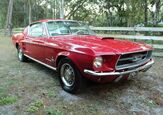Toyota GR86 Trueno Edition vs Subaru BRZ tS Comparison

Co-written with Jeff Wilson
Do not adjust your screens: you are not looking at two different colors of the same car.
You might recognize the Subaru BRZ tS and Toyota GR86 Trueno Edition from our recent affordable sports car comparison. These two models have always been close—rolling off the same production line will do that—but both of their respective makers have produced these new editions for 2024. With a focus on improved handling and braking, they're still quite similar, but like Cobb in Inception, we needed to go deeper. For this one, contributing writer Jeff Wilson is Team Subaru, while I represent the red corner for Toyota.
Read on for the full sibling rivalry, brought to you by WeatherTech.
Interior and exterior
Jeff Wilson: The BRZ is a sleek and handsome car, and amid the vast sea of crossovers, this is a beacon of style that reminds us that we as a population used to drive things that had a bit of sensuality in their curves. Because they’re low and wide, I find my eye always drawn to them when I see them on the road – old ones and new. And finished in this new deep blue paint, our tS tester looks more premium than it is.
We generally prefer the front-end treatment of the GR86 to the BRZ’s, and the Toyota’s duck-tail rear spoiler is a must-have, but in this test, with all the stickers and decals slapped on, the GR86 Trueno looks like a car for someone who’s never grown up, making me prefer the slightly more subtle Subie.
Inside, the BRZ’s coal-bin black interior is brightened somewhat by a few flashy blue trim bits and stitching. The Toyota splashes out with bigger swaths of red accents, but otherwise, apart from differently-shaped shift knobs and the Subie’s red STI starter button, they’re pretty much identical.
The BRZ’s interior finishes may not be as premium as its flashy blue paint and sleek lines suggest, but it is a functional interior with the steering wheel and shifter placed perfectly, a proper hand-crank parking brake, and proper, real buttons and knobs for essential touchpoints, rather than haptic panels. The digital gauge display and primary touch screen feel a generation or two out-of-date with rather dull, low-res graphics, but with a plugged-in phone, it provides effective (if a bit lag-prone) CarPlay connectivity.
Kyle Patrick: These two have the same basic proportions. The low nose, tight overhangs, and pert tail still mark them out amongst a landscape of SUVs and front-drive hatchbacks. Just like most twins, these two have found their own style over the years. Remember: the Toyota frowns, the Subaru smiles. The Trueno Edition takes inspiration from Initial D, adding super-subtle black stripes along the sides and on the hood, plus unique 10-spoke 18-inch alloy wheels. To me, it just looks a little strange in red instead of white, but hey, maybe it works for you. We both agree that ducktail spoiler is a big advantage for Team Toyota.
There’s even less difference between these two inside. Both have nicely supportive leather/suede sport seats but an archaic, simple dashboard design—although the suede above the digital instrument cluster is a nice touch. If we’re going to pick nits, which is the point of this whole face-off, the Toyota’s shift topper is cooler. What it lacks in flair it makes up for in usability, mind you: there’s no second-guessing how to access anything in the GR86’s cabin. The 2+2 layout is admittedly tight, no doubt about it—but it works in a pinch, and it allows the car to swallow a surprising amount of stuff if you make use of the pass-through.
The Subaru-sourced, 8.0-inch touchscreen is not pretty. Nor is it particularly quick. It still needs a USB-A cord for wired phone mirroring too. And guess what? So does the Subaru. So bam, tie game.
Powertrain and driving dynamics
JW: Of course, it’s not the looks, nor its cabin that makes the BRZ such a fun machine. It’s all about the driving dynamics. With a curb weight of just over 2,800 pounds (1,270 kilograms), the whole car weighs about the same as the battery pack in a midsized crossover EV.
This relative feather-weight works with the super-low center of gravity and squat stance to make the BRZ change directions like a caffeinated chipmunk. Plus, those tS badges mean it’s been tuned by Subaru’s STI performance wizards. They’ve given it some new Hitachi-Astemo front dampers, and tweaked the rears for improved responsiveness. A set of Brembo brakes let a driver go a bit deeper into the braking zone before hammering on the whoa! pedal, knowing that there’ll be plenty of stopping power.
It's not a revolutionary change since even the base model BRZ is a pretty frisky performer, but it all helps sharpen up the Subie’s reflexes incrementally enough to add to its already considerable enjoyment. On its own, it’s a sensationally fun and rewarding machine.
Drive it back-to-back with the GR 86, though, and the Subaru’s slightly more compliant ride translates into a backend that’s not quite as sharp and settled as the Toyota’s over rough pavement.
Then there’s also the matter of the BRZ’s engine (and the GR 86’s, for that matter) which aren’t as free-revving as the Mazda MX-5's, and the 2.4-liter Boxer engine isn’t exactly musical in its sounds, either. Worse still, when coaxed to wind out, the BRZ still suffers from some rev-hang between shifts, making it slightly less engaging, and done no favors by a somewhat notchy shifter. Toyota has said that minor software changes are coming for the 2025 GR86 to make it more willing during throttle-blipping, and we’re hoping Subaru will do the same for the BRZ, too.
Despite its deficiencies, the BRZ’s boxer is a tractable engine that offers usable power throughout its range.
KP: If you’re hoping the GR86 has more power, well then bad news. It’s still working with the same 228-horsepower 2.4-liter four-cylinder as before. But the added torque and improvements to the six-speed manual make it a much better daily driver than the first-gen car.
The Trueno picks up a new Performance package that is standard on this limited edition. Both of these cars feature Brembo brakes, but like Fleetwood Mac, the Toyota goes its own way with a new set of Sachs dampers. The result is a car that is just that little bit sharper, one better suited to the occasional thrash on track. The brakes are super, full of bite and low on fade.
Pushing both cars through the twisty roads around here, they are initially—and unsurprisingly—very similar. The engine wakes up over 4,000 rpm, shedding that rattly soundtrack at low revs and egging the driver on. The shifter is a little loose but otherwise pleasantly mechanical in operation. When you’re pushing, it smooths out, and the rev hang more or less disappears.
It’s the dampers that make the difference here. Drive ‘em back to back and there’s a bit better body control in the Toyota. Mid-corner undulations can upset both, but it’s the GR86 that settles a half-step sooner.
Value
JW: Ultimately, being so similar, choosing between a BRZ and GR86 is likely to have as much to do with styling preference, or the availability of a car on a dealer lot as anything else. When driven back-to-back, there’s just enough of a difference in the suspension tune to make us prefer the Toyota, and given that the GR86 Trueno is slightly more affordable than the tS for US customers, it’s a smart choice. In Canada, the opposite is true with the BRZ tS not only squeaking in under the Trueno’s pricing, but also ringing in notably cheaper than the MX-5 and Mini Cooper S, making it a heck of a value that outweighs the negligible suspension differences.
KP: Good news to folks in America: the better-driving car is also the better deal. At $35,815, you’re saving a few hundred bones compared to the Subaru. That’s if you can find one, mind you: there’s just 860 Truenos coming for 2024.
It’s even tougher in Canada, where just 50 examples of this model will show up for a McNugget combo more than $41,000 all-in.
Verdict: Toyota GR86 Trueno Edition vs Subaru BRZ tS
Driving these two back-to-back, we still just slightly prefer the Toyota. That was the case in the original four-car feature, too.
However, in that one, the Subaru's Canadian pricing helped swing the scores, getting the Pleiades team the win. If you're watching in America though—where the Trueno isn't just more affordable, but relatively more common than its double-digit count in Canada—then the Toyota is both the better deal and the better drive, and thus the winner here.
Become an AutoGuide insider. Get the latest from the automotive world first by subscribing to our newsletter here.

Kyle began his automotive obsession before he even started school, courtesy of a remote control Porsche and various LEGO sets. He later studied advertising and graphic design at Humber College, which led him to writing about cars (both real and digital). He is now a proud member of the Automobile Journalists Association of Canada (AJAC), where he was the Journalist of the Year runner-up for 2021.
More by Kyle Patrick










































Comments
Join the conversation
Can't speak to Toyota, But when will Subie do the right thing? Put the WRX engine in the BRZ and go all wheel drive along with the brembos etc?
I like Joe's thinking about the WRX engine, but I would want to keep the subtle paint job of the BRZ featured in the article. Also, I find the Walmart style tape job on the Toyota kinda juvenile. I did something similar to my Ford Fiesta 50 years ago, because, you know, it had a formula Ford engine in it! 😆